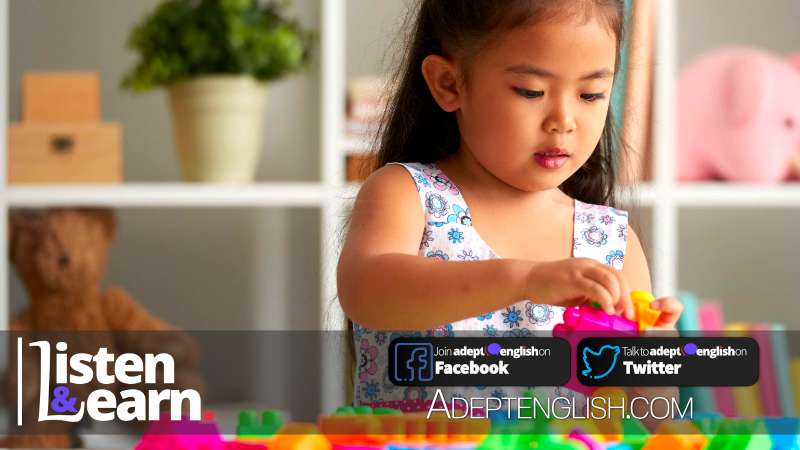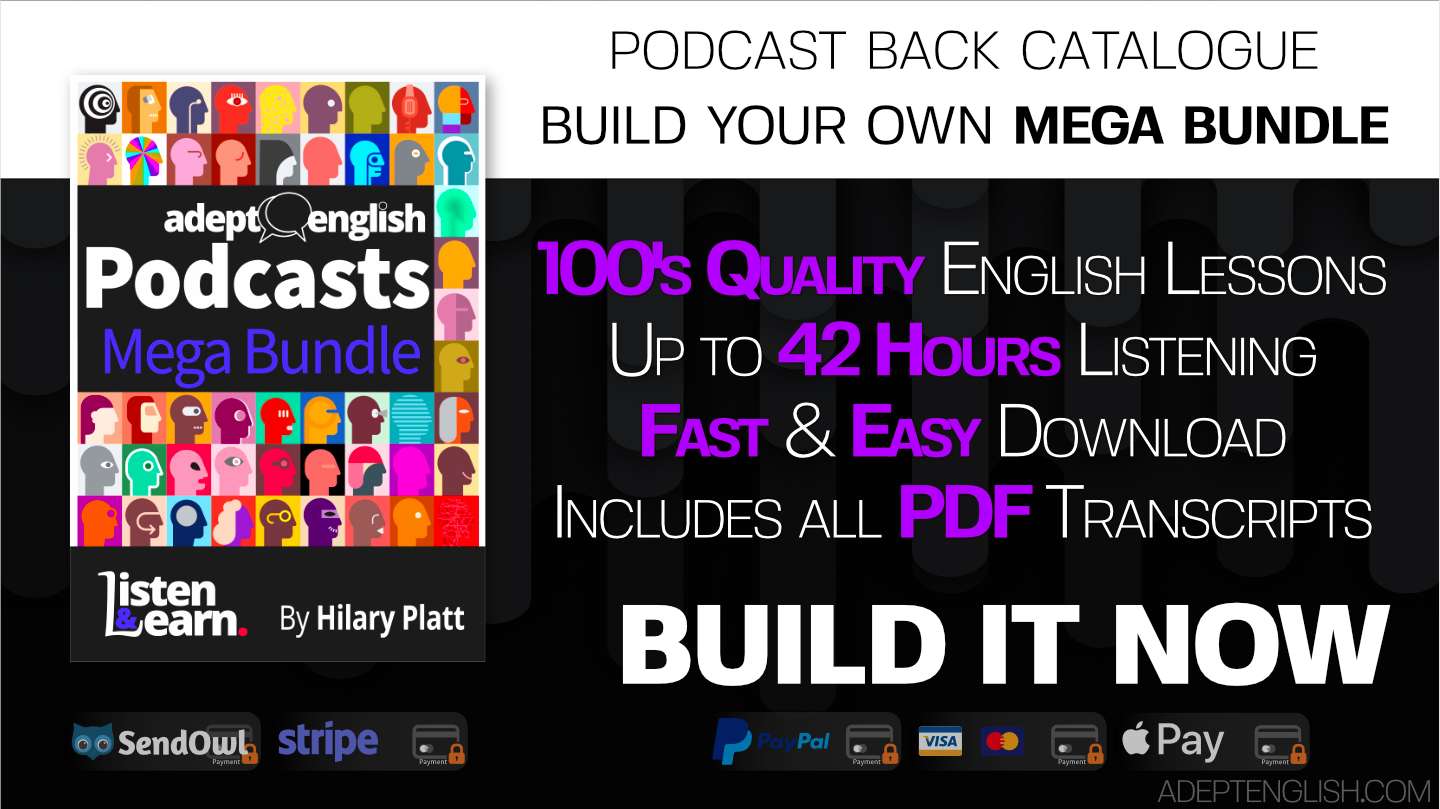How To Learn English Speaking
We get a lot of emails and messages on Facebook asking us “How to learn English speaking?” questions. The quick answer is lots of listening to English being spoken by native English speakers and then getting familiar with hearing English being spoken so you understand much more than you can speak.
Learning any language, even your first language, comes from listening to lots of people speaking in that language, and observing and understanding the meaning of the sounds you are hearing, learning that those sounds are important and need to stored in your longer term memory and learning to mimic the sounds you hear. You start by practising the words in your head, then alone, and then when you're ready you practice the words with other people.
You see this happening all the time. Look at any small child. Point at something, say the word (and repeat over and over) and eventually the child associates the words with objects and actions. What we do here at Adept English is more sophisticated and takes advantage of the fact you are not leaning about languages from scratch. But it’s still the same basic process.
If you want a longer answer on how to learn to speak English, then you should check out our free English language course, which goes into much more detail about our “Listen & Learn” system of learning to speak English fluently.
Most Unusual Words:
Runny
Circumflexes
Shrove
Most common 4 word phrases:
| Phrase | Count |
|---|---|
| A Pinch Of Salt | 3 |
| How To Make Pancakes | 2 |
| Learn To Speak English | 2 |
| So That You Can | 2 |
| In The UK But | 2 |
Listen To The Audio Lesson Now
The mp3 audio and pdf transcript for this lesson is now part of the Adept English back catalogue . You can still download and listen to this lesson as part of one of our podcast bundles.Transcript: How To Learn English Speaking While Making Pancakes
Hi there and welcome to this podcast from Adept English. How to learn English speaking and learn to speak English fluently as an adult? Well, if this is your question and your quest, then if you listen to Adept English regularly, you’ll know that the answer is to get really, really familiar with the English language through listening. And this is why we provide you with lots of podcasts to listen to. So in answer to how to learn English speaking, I’d also suggest that English is best learnt in a way which is closest to how we learn language as children. And that’s with the familiar. ‘Familiar’, F-A-M-I-L-I-A-R is an adjective and the literal meaning of ‘being related to family’, but ‘familiar’ means someone or something which is well-known to you, someone or something that you’re close to.
Video
So how about we do some English language learning today, which is about something you’re probably familiar with, something which may happen in your house, as it does in mine? Let’s make some pancakes – in English, of course! Let’s get some English about really familiar things into your head today! And if you don’t eat or make pancakes like this – then it’s something new to try.
“I'm just someone who likes cooking and for whom sharing food is a form of expression.”
▪️ Maya Angelou, American Poet
I gave you some brief tips last year, when I was describing Shrove Tuesday or Pancake Tuesday which we celebrate in the UK, but today let’s do full instructions, so that you can make yourself, as you listen!
Learn English with the familiar – pancakes!
So pancakes – that’s P-A-N-C-A-K-E-S. I would imagine they’re called something different in your language. The French crêpe, C-R-Ê-P-E is perhaps the more internationally known word for them. Notice that little circumflex there on the ê in crêpe – it makes it really short - ‘crêpe’. We don’t have circumflexes in English. So let’s talk through how to make pancakes today – so that we’re talking about something which is probably familiar to you, but which you may not have thought through in English. Learn English at home, as though English was being spoken in your home – that’s our aim here! How to learn English speaking at home.
So this recipe, this method of making pancakes is the one that my mother used to use. Recipe – R-E-C-I-P-E – is a difficult word to pronounce if you don’t know it – certainly from the spelling that is. And my pancakes are very popular in our house – my children say that they’re ‘more like a crêpe than the American pancakes’ which they also like.
How to make pancakes – recipe and method
So here goes. If you’re using a fairly large frying pan – so a pan, P-A-N, perhaps 9 inches or 22 cm across the base – then this mixture will probably make around 8 pancakes. You’ll need a pan with sloping sides ideally, so you can just slide them onto a plate when they’re cooked.
You’ll need a bowl, B-O-W-L. And you need to weigh out 4 ounces (or around 113g) of flour. That’s flour, F-L-O-U-R – so the white powder that’s used to make cakes and bread. What we call in the UK ‘plain white flour’ is probably best – so it doesn’t have any raising agent in, like the flour that you’d use for cakes. So put your flour into the bowl, and add a pinch of salt. A ‘pinch’ of salt – means the amount of salt that you can ‘pinch’ or hold between your thumb and forefinger – so really just a little bit of salt. Recipes often say ‘a pinch of salt’ – so this is what they mean.
Video
Make a dip in the centre of the flour and add 2 eggs. You’ll need a fork and some energy – you need to stir the mixture with a fork until it’s combined, until the eggs and the flour are entirely mixed to form a smooth batter. Batter is spelt B-A-T-T-E-R – and that’s a noun which means a smooth mixture, made with flour. If you have fish and chips in the UK, then the fish will have been coated in batter before cooking to make it crispy. British Yorkshire puddings are also made from batter. So if you start mixing with a fork and you’ve got lumps in your batter, don’t worry. Just keep mixing and mixing and mixing – and eventually your lumps of flour will disappear, they’ll be mixed in. Make sure all the flour from the sides of the bowl and the base of the bowl are mixed into the batter. It’s quite satisfying!
Then you need to mix 7 fluid ounces of milk – that’s 200ml, if you’re metric. In the UK we do both metric and imperial measurements. And 3 fluid ounces of water – so that’s about 75ml of water. You can use various kinds of milk – normal cow’s milk, but also soya milk works too. So mix the milk and water and then gradually add this to your batter, stirring as you go – until you’ve got something which is nice and smooth and runny. ‘Runny’, R-U-N-N-Y as an adjective means it’s quite liquid, it ‘runs’ when you tip the bowl.
Success cooking your pancakes!
Now heat your pan and you’ll need it quite hot for pancakes. And drop some butter into your pan – enough to coat the sides. Tip out any excess butter – ‘excess’, E-X-C-E-S-S means ‘too much’. You only want to coat the pan and it doesn’t matter if the butter goes brown. You can re-use what you’ve tipped out for the next pancake.
📷
A photograph of a young family laying on a bed with a small child's story time.
Now pour in some pancake mixture into the pan – round the edges is good and quickly while it’s still a liquid, tilt the pan from side to side, so that the mixture runs and covers the whole of the bottom of the pan. You’ve only got a few seconds to do this before the pancake starts to set, to become firm. If you’ve ended up with an odd shape, or there are holes in your pancake, then you can add just a little more pancake batter into the pan to cover any holes up!
Then wait. If you try to move your pancake around too soon – you’ll spoil it. You need to wait until it’s set, cooked on the bottom. When you notice that it’s turning slightly brown on the edges, you can take a peek, a look underneath by carefully lifting the edge. If it’s light brown on the bottom, see if you can slide the pancake around in the pan. If it moves easily, then you’re ready to flip. The verb ‘to flip’, F-L-I-P means you toss it up into the air with a spin, so that when it lands back down in the pan, it’s the other way up. It takes a bit of practice – if you’re not sure, turn the pancake over with a spatula. But flipping is fun.
What do you eat your pancakes with?
Cooking the second side of the pancake is easy and will happen more quickly – you’re just aiming to brown it slightly. Once it’s cooked on the bottom, slide the pancake out of the pan, onto a pre-warmed plate. And remember you’ve got around 7 more to make – so it’s quite sociable cooking – you’ll need several other people to eat them with you. What to eat your pancakes with? Well, lemon juice and sugar is traditional in the UK. But jam, Nutella, maple syrup, honey – all of these are good. I’ve never tried it, but I’m sure that this recipe would be fine for savoury pancakes too – mushrooms, cheese, ham, whatever you like. With practice, you’ll be able to make thinner pancakes – and you’ll probably get more pancakes out of this mixture.
Download The Podcast Audio & Transcript
There you are. How to learn English speaking and make pancakes at the same time. If you want to learn to speak English better, but you feel that you need help making the basic English vocabulary stick in your head, then you’ll find help in our Adept English 500 Most Common Words Course. This course is available to buy on our website – and it contains only the 500 most frequently used words in English – so that you can practise them, so that you will become familiar with then and comfortable with those words. The fastest way to be fluent is become familiar with the most used words.
Boost Your Learning With Adept English
If you were to analyse the transcript of this podcast, those 500 most used words would make up most of what I’ve said to you! So buy the 500 Most Common Words course today – then you can make sure that your basic English is good and improve your fluency.
Goodbye
Anyway, enough for now. Have a lovely day. Speak to you again soon. Goodbye.










